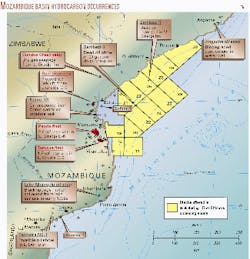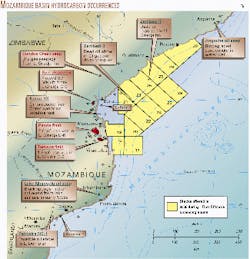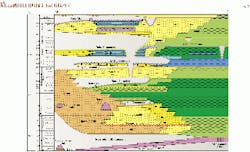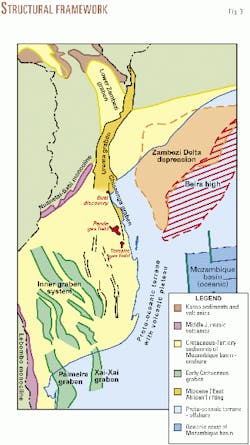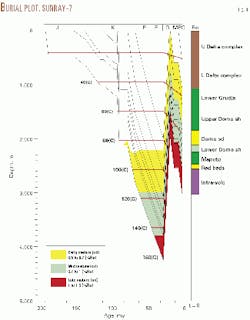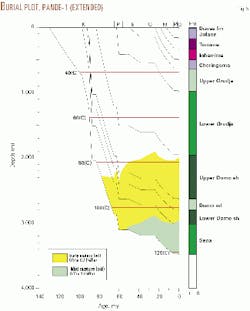Africa in Perspective: Mozambique basin may have bright future under new geological interpretations
In this article we present a new perspective on the geology and petroleum prospectivity of the Mozambique basin. It is a synthesis of an open report1 recently prepared by ENH-ECL which includes a modern view of continental break-up and basin evolution and an assessment of information derived from exploration the last 14 years.
The Mozambique basin occupies the broad coastal plain and continental shelf of southern Mozambique. It covers 500,000 sq km out to the 2,000 m isobath, of which 275,000 sq km are onshore. A total of 72 wells (49 exploration, 23 appraisal) have been drilled in the basin since the early 1950s. Blocks covering part of the offshore Zambezi Delta were offered in the first offshore licensing round which closed in October 2000.
Although the basin is generally sparsely drilled, two giant gas fields at Pande and Temane have already been discovered and appraised (Fig. 1). Pande had original gas in place of 3 tcf, of which ENH reports 2.6 tcf as reserves. Condensate is recovered at a rate of 1.87 bbl/MMcf.
The Upper Cretaceous Lower Grudja formation G-6 sandstone reservoir has 30% porosity and permeability in the range of 200 to 1,000 md.
At Temane the Lower Grudja formation G-9 sandstone reservoir has an average porosity of 31% and permeabilities up to 5,000 md. Temane has original gas in place of 2 tcf, of which 1.8 tcf are reserves. In addition to Pande and Temane, another significant discovery has been made at Buzi, where dry gas was tested at the rate of 8.7 MMcfd on a 1/2-in. choke from the G-9 sandstone.
There is an acknowledged potential for further gas discoveries in stratigraphic and structural traps in the relatively poorly explored Mozambique basin. This and the developing market for cleaner fuels in Southern Africa help to maintain gas as an attractive exploration target.
In addition to the undoubted gas potential of the basin, tantalizing indications of liquid hydrocarbons have been reported as shows in a few offshore wells, e.g., Nemo-1 produced a small volume of oil on wireline test, and an unconfirmed surface seepage near Lake Nhangela in southern Mozambique (Fig. 1).
Surface oil occurrences have also recently been recorded and investigated by Lonropet in the adjacent Rovuma basin of northern Mozambique.
In this article we attempt to rationalize the oil potential of the Mozambique basin in terms of a modern understanding of the basin's stratigraphic and structural history.
Basin evolution
The evidence for the break-up of southwestern Gondwana has been traced through episodes of volcanicism, tectonics, oceanic crust formation, and basin development in both southeastern Africa and the conjugate Antarctic margin of western Dronning Maud Land (DML).
The arguments about break-up and the paradox of a 30 Ma gap between Early Jurassic plume-related Karoo-DML magmatism and eventual separation revolve around new concepts of 'volcanic margin' development. In this model early sea-floor spreading was most likely subaerial, forming seaward-dipping reflector (SDR) sequences composed of volcanics and interbedded sediments.
This constitutes so-called "proto-oceanic crust" and forms the basement to the Mozambique basin. Many wells in the Mozambique basin terminated in volcanics and interbedded sediments previously ascribed to the "Karoo." Recognizing that Mid Jurassic volcanics are related to break-up means that the paradoxical time gap is bridged and a causal link identified between Karoo plume development and continental separation.
This idiosyncratic origin and evolution has resulted in the diverse structural and stratigraphic picture for the Mozambique basin shown in Figs. 2 and 3.
The Mozambique basin has formed almost entirely over "proto-oceanic crust," but the adjacent continental margin inherited Karoo basins formed by intracratonic sag (Carboniferous-Permian, "Lower Karoo"), and transtensional "pull-apart" rifting (Triassic, 'Upper Karoo'), e.g., the Lower Zambezi graben. Initial "Karoo" intracratonic plume volcanism (c. 190 Ma) was followed by SDR development and sub-aerial spreading. The Mid Jurassic volcanics of the Lebombo and Nuanetsi-Sabi monoclines may represent the landward expression of SDRs (Fig. 3).
Prebreak-up rifting was probably suppressed by regional uplift associated with plume impingement. It is proposed that SDR formation continued seaward during the initial separation of southeast Africa and Antarctica during the Mid to Late Jurassic.
The first submarine spreading and the formation of true oceanic crust took place in the Mozambique Basin in the Late Jurassic (M22-Kimmeridgian).
Initial "post-rift," thermal-cum-flexural subsidence was retarded by the persistence of the plume in the region. Subsidence therefore did not accelerate until the Early Cretaceous when the direct influence of the plume was weakened as the plate moved relatively northeastwards.
Early Cretaceous formation of rift grabens over the SDR ("proto-oceanic") terrane (the Xai-Xai graben and Inner graben System) reflect extension associated with continued separation-oceanic crust formation in the Mozambique basin, beginnings of movement on the Agulhas-Falklands Fracture Zone, and sea-floor spreading in the Natal Valley to the south. The "proto-oceanic" terrane offshore is characterized by features here called "volcanic plateaux," which are considered to be small-scale analogs of oceanic plateaux.
Interruptions to steady-state subsidence in the Mozambique basin, which formed tectono-stratigraphic breaks, include the cessation of spreading in the Mozambique basin (M2-Aptian), the rise of the Marion plume (centered in southeastern Madagascar) at c. 90 Ma, the initiation of spreading in the Mascarene basin at 84 Ma, and the rise of the Deccan plume and spreading along the Carlsberg ridge at c. 65 Ma.
The influence of Miocene East African rifting is seen as the Lake Niassa rift to the north and the southerly extensions of the Chire and Chissenga graben, a north-south graben system which cuts across the Lower Zambezi graben and extends into the central onshore-offshore part of the Mozambique basin (Fig. 3).
Faulting of this generation is observed further south where it has been interpreted as a broadening out of the rift system into a low displacement system.
In the northern part of the Mozambique basin, both onshore and offshore, the Zambezi Delta has formed an area of depressed crust-the Zambezi Delta depression. Delta progradation and sediment loading appears to have begun in Late Oligocene-Early Miocene times.
Further off the Zambezi Delta lies an enigmatic structural feature, the Beira high. Stratigraphic relationships showing Cretaceous sediments onlapping this high and a possible deeper block-faulted character suggest that the feature is fundamental and not just a product of deltaic sediment loading and depression on one side.
New perspectives
This modern view of regional geology, we believe, has significant implications for the petroleum prospectivity of the Mozambique basin.
Source rocks. In the new interpretation SDR sequences have the potential to include source rocks in terrigeneous sediments interbedded with volcanics (e.g., the evidence of the Sunray-7 well with TOCs over 1% in intravolcanic SDR shales).
Note on previous interpretations this section was occupied by highly lithified and therefore unprospective, Permo-Triassic, Karoo sediments. Domo shales have traditionally been considered as the source rock for Pande and Temane gas, but maturity considerations (see below) suggest that there is a deeper prebreak-up source.
Immediate postbreak-up submarine conditions (Late Jurassic to Early Cretaceous) provided a unique environment for the development of anoxia and the formation of oil-prone source rocks. The DSDP-ODP and exploration drilling record demonstrates that anoxic conditions developed in what is designated here as the "Afro-Antarctic Domain" during the early break-up of southwestern Gondwana.
O'Connell and Wise2 postulated that the existence of major physical barriers coupled with a sluggish, haline-driven global oceanic circulation system, set the stage for the basinwide accumulation of black shales. The record also shows regional Early Albian ventilation which would restrict the stratigraphic time interval for source rock development to Callovian-Oxfordian through Late Aptian (Fig. 2).
The occurrence of organic-rich intervals within the Upper Jurassic to Aptian section of the offshore Mozambique basin and sometimes extending by transgression over the onshore is therefore confidently predicted. The possible existence of syn-break-up (Mid-Late Jurassic) or post-break-up (Valanginian-Aptian) rift basins (e.g., Xai-Xai graben, Inner graben, Lower Zambezi graben) further enhances the possible occurrence of anoxic (marine or lacustrine) source rocks in the Mozambique basin.
Basin modeling
There are several reasons why the thermal, and therefore source rock maturity, history of the Mozambique basin are idiosyncratic:
- Plume development resulted in suppressed break-up related rifting but increased initial heat flow.
- Magmatic underplating linked to plume development will have played a role in early heat flow enhancement which may have continued into the post-break-up phase, and contributed to source rock maturity.
- A complex pattern of intra-basin subsidence and uplift induced by post-break-up tectonic events.
A complex and variable thermal history has been shown by basin modeling (using patented Basin Mod software) conducted on several wells in the Mozambique basin. All wells in which preliminary modeling has been carried out, (with the exception of Pande-1 and Sofala-1 see below), require significant uplift and erosion during the Late Cretaceous or Tertiary in order to achieve an acceptable calibration between the modeled results and the available maturity data.
Satisfactory models can be constructed using various combinations of paleo-geothermal gradient and section removed by uplift and erosion. However the major conclusion is that most wells require kilometer scale uplift and erosion in order to produce satisfactory basin models (Fig. 4).
The timing of this uplift is not constrained directly by the maturity or stratigraphic data. Significant unconformities occur throughout the Upper Cretaceous and Tertiary section, but the modeling work suggests that the dominant uplift episode occurred at either the Oligocene or Miocene unconformities.
This uplift and erosion has important consequences to prospectivity, particularly in terms of maturity development and the timing of hydrocarbon generation with respect to trap formation.
A consequence of the uplift and erosion is that maximum hydrocarbon generation has occurred in the past, i.e., during burial prior to the uplift. This is a critical recognition since early formed traps (structural or stratigraphic) will have the best likelihood of being charged with, and ultimately retaining, liquid hydrocarbons. Early trapped gas is less likely to have survived leakage or re-migration.
Pande-1 and Sofala-1 are the only wells so far that have been modeled with maximum temperatures (hence maximum gas generation) at present day, so-called "maximum temperature now" (MTN) condition (Fig. 5). This suggests that recent thermal history may exert a prime control on the chance of accumulation at the present day, and that late-formed traps (which may include Pande and Temane) have a better chance of a gas charge. Conversely late-formed gas prospects should be sought in areas of MTN.
Enhanced prospectivity
We believe that the recognition that the Mozambique basin has developed over a "volcanic margin" has profound implications for the petroleum prospectivity of the basin. It has affected all aspects of petroleum geology including the occurrence and development of reservoirs and source rocks, and has strongly influenced source rock maturity history.
Basin modeling is a key tool in exploration because timing of hydrocarbon generation versus trap formation is a critical factor in such a complex thermal and structural evolution.
References
- ENH-ECL, "The Petroleum Geology and Hydrocarbon Prospectivity of Mozambique '2000,' Open Report, Vols. 1 and 2.
- O'Connell, S., and Wise, S.W., "Development of Mesozoic Organic-Rich Sedimentary Facies Across Southwestern Gondwanaland Margins and Basins," AAPG Bull., Vol. 74, 1990, p. 732 (abs.).
The authors
Andy Matthews is an associate geologist with Exploration Consultants Ltd. He began his career in 1973 and joined ECL in 1983. He subsequently worked for Intera and Schlumberger GeoQuest before returning to ECL in 1999. He holds a BSc Hons. degree in geology from London University. E-mail: [email protected]
Steve Lawrence is chief geologist at ECL. Before joining ECL in 1978 he was an operations and exploration geologist for Amoco UK and Cluff Oil Ltd. He has a BSc Hons. degree in geology from London University. E-mail: [email protected]
Amad V. Mamad is a geologist at ENH. From 1992 and up to joining ENH in 1998 he was a geologist for the National Directorate of Geology of Mozambique (Geological Survey). He holds a BSc Hons. degree in geology from the University Eduardo Mondlane-Mozambique. E-mail: [email protected]
Guilhermino Fortes is exploration manager at ENH. He began his career in 1978 and joined ENH in 1981. He holds a bachelor of geology degree from the University Eduardo Mondlane-Maputo and a post-graduate diploma in basin evolution from Royal Holloway and Bedford New College. E-mail: [email protected]
